Alaska Airlines Mileage Plan has long been a favourite program for Canadians, with a co-branded credit card here north of the border and many premium redemptions available through the program.
Last week, Alaska Airlines officially joined the Oneworld alliance. We’re all waiting with bated breath to see if our favourite sweet spots will change. For now, no news is good news, but the reality is there’s not much to say about Alaska mileage redemptions on partner flights because nothing has been announced yet.
Instead, let’s focus on what we do know, and look at it from the other side. As a full-fledged alliance member, we’ll be able to make partner mileage redemptions on Alaska flights as well.
This opens up some new doors for redeeming British Airways Avios, Cathay Pacific Asia Miles, and American Airlines AAdvantage miles on Alaska’s flight network, as we have no shortage of Oneworld programs to choose from.
More Oneworld Connections for Western Canadians
While the Oneworld alliance has some great options for travelling the world, it’s nowhere near as easy to use as Star Alliance via Aeroplan. The biggest criticism of Oneworld is that has a very underdeveloped route network in Canada.
Prior to Alaska joining, Oneworld serviced a grand total of four Canadian cities: Vancouver, Calgary, Toronto, and Montreal. For those of us lucky enough to live in those major urban centres, we could easily book longer itineraries.

We could even take advantage of transiting through larger US hubs, via American Airlines flights, all on a single award ticket. This is great when booking with a points program that uses a region-based chart, because tacking on an extra connection to get home won’t increase the cost of the ticket.
However, our friends in places like St. John’s, Winnipeg, or Whitehorse don’t have the same luxury. You’d have to separately book a positioning flight to one of the four Canadian gateways, or directly to a hub like Los Angeles, Chicago, or New York, before embarking on your Oneworld journey. Whether it’s with Aeroplan, Air Miles, Aventura, or cash, this additional ticket is a cost you simply can’t avoid.
Now, with Alaska joining the alliance, we can bring that number up to seven. Victoria, Kelowna, and Edmonton are now directly serviced by a Oneworld partner, opening the door for onward travel on a single ticket. Vancouver and Calgary have also gained direct access to Seattle, whereas before we’d be limited to using other US airports for overseas travel.
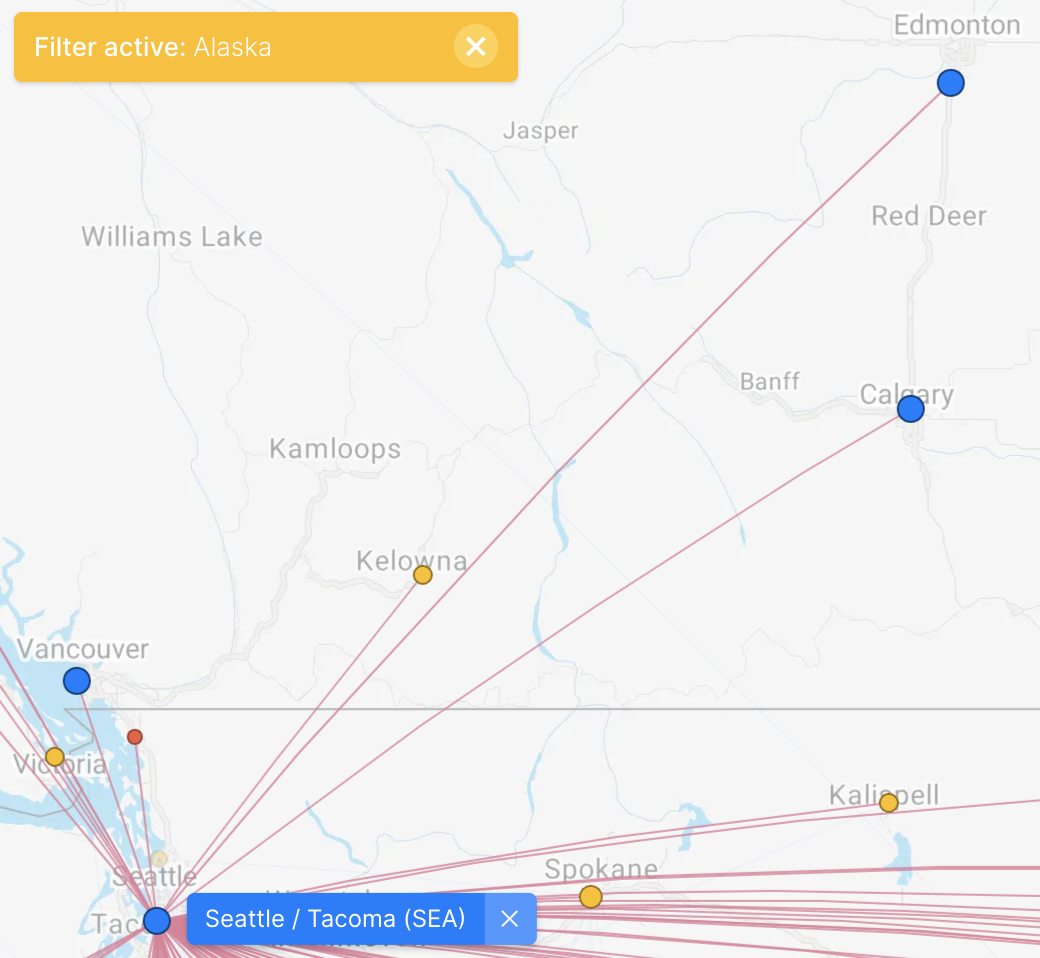
Although they’re growing as a competitive hub, and the addition of Alaska certainly helps with that, Seattle’s long-haul routes and lounges aren’t as numerous as what you’ll find flying out of other, larger US cities. It’s quite likely that you should expect to make another US connection before continuing onto your final destination.
If you’re flying from Kelowna and aspiring for Cathay Pacific First Class, for example, you’d have to hop to Seattle, then San Francisco, before enjoying the prime attraction. While all of those short-haul connections are a bit of a chore, you’d have to make a few stops anyway, and previously it would’ve come at the cost of a separate ticket.
Unfortunately, unless a Canadian airline joins Oneworld, I suspect the rest of us will have to continue making separate arrangements for positioning flights. We’re spoiled with the strong interconnectivity that Air Canada provides, and the alternatives can be a real challenge for all but the most centralized Canadians.
Alaska Flights on Oneworld Multi-Carrier Awards
One of the most enticing features of Oneworld is the wide variety of top-notch airlines and premium cabins to sample. Luckily, we have a few ways to do so at very affordable rates.
British Airways Avios and Cathay Pacific Asia Miles both use a different award chart for itineraries that include travel with more than one Oneworld partner airline. There’s great value to be found here for longer trips, often better than what you’d get for booking single flights with one partner at a time.
In fact, regular distance-based partner awards are usually terrible value in the Avios program because each segment is priced individually. Here’s the breakdown of a potential itinerary from Edmonton to Doha in Qsuites, consisting of two separate Avios awards:
- Edmonton to Seattle: 559 miles = 6,000 Avios in economy on Alaska Airlines
- Seattle to Doha: 7,411 miles = 154,500 Avios in business class on Qatar Airways
In total, this would set you back a whopping 160,500 Avios for a one-way ticket, and not even in First Class! Once you break the 7,000-mile barrier, that top distance band really blows your costs out of proportion.
At that rate, the Alaska to Seattle connection doesn’t benefit you at all. You’d be much better off paying 25,000 Aeroplan points for Air Canada business class to Montreal, and then only 92,750 Avios to Doha.
However, now that Alaska has joined Oneworld, we can combine their flights with other Oneworld airlines and take advantage of the multi-carrier award chart.
Indeed, by travelling on Alaska and Qatar via Seattle, you’ve already met the requirement to use two Oneworld partner airlines, and the more appealing multi-carrier award chart will kick in automatically if you make the booking over the phone.
Miles in your journey | Avios required for... | |||
Economy | Premium economy | Business | First | |
0–1,500 | 30,000 | 45,000 | 60,000 | 90,000 |
1,501–4,000 | 35,000 | 52,500 | 70,000 | 105,000 |
4,001–9,000 | 60,000 | 90,000 | 120,000 | 180,000 |
9,001–10,000 | 70,000 | 105,000 | 140,000 | 210,000 |
10,001–14,000 | 90,000 | 135,000 | 180,000 | 270,000 |
14,001–20,000 | 100,000 | 150,000 | 200,000 | 300,000 |
20,001–25,000 | 120,000 | 180,000 | 240,000 | 360,000 |
25,001–35,000 | 140,000 | 210,000 | 280,000 | 420,000 |
35,001–50,000 | 160,000 | 240,000 | 320,000 | 480,000 |
With a cumulative distance of 7,970 miles for Edmonton–Seattle–Doha one way, or 15,940 miles round-trip for a simple out-and-back, you could get a round-trip business class ticket for 200,000 Avios. At effectively 100,000 Avios for one-way travel, that’s much better value than your other options.
If you ask me, the beauty using the Alaska/Seattle link is that it lets you maximize your time in desirable cabins for a competitive award price. For travel to Doha, our friends in Victoria would get one hour on Alaska’s Dash-8 propeller plane, followed by 14 hours on Qatar Airways Qsuites. I’d certainly take this over flying through Montreal on a separate Aeroplan ticket, with five hours on domestic Air Canada, then 12 hours in Qsuites.
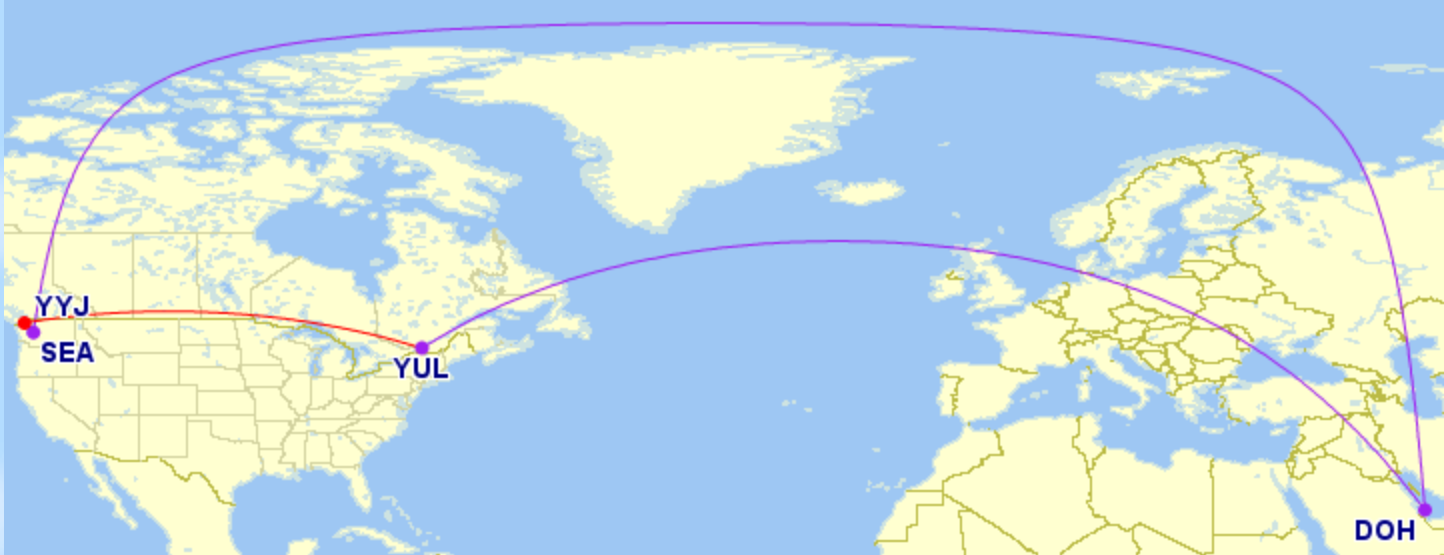
(Of course, this depends on your exact origin, destination, and everything in between. Flying over the Pacific or through a more southerly hub might introduce more zig-zagging for either option.)
You’ll have tons of flexibility, too. An Avios multi-carrier award allows up to eight segments plus one open-jaw, and comfortable multi-night stopovers allowed at each destination along the way. With over 4,000 miles to spare before the ticket jumps up to the next price point (for itineraries longer than 20,000 miles), there’s no shortage of creative routes you could take.
For example, you could “nest” a highly-productive Middle East hopper to Beirut, Amman, and Cairo via Royal Jordanian Airlines, then return home the exact same way you came:
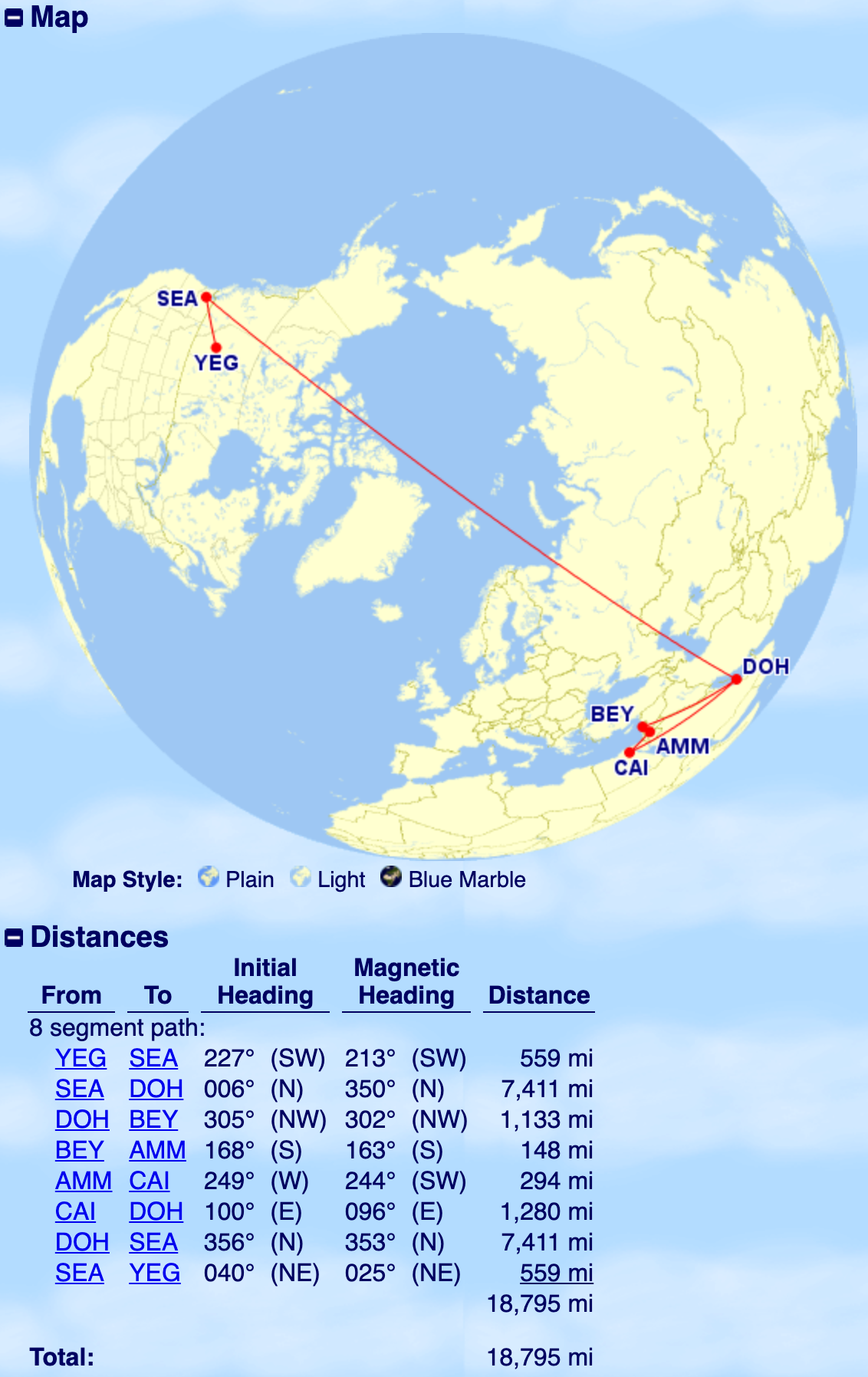
Clocking in under 20,000 miles, you could fly this entire itinerary in business class for 200,000 Avios, with proper stopovers in each city.
Or you could fly home the long way around, adding a few Asian destinations and indulging in JAL and Cathay’s top-tier business class cabins:
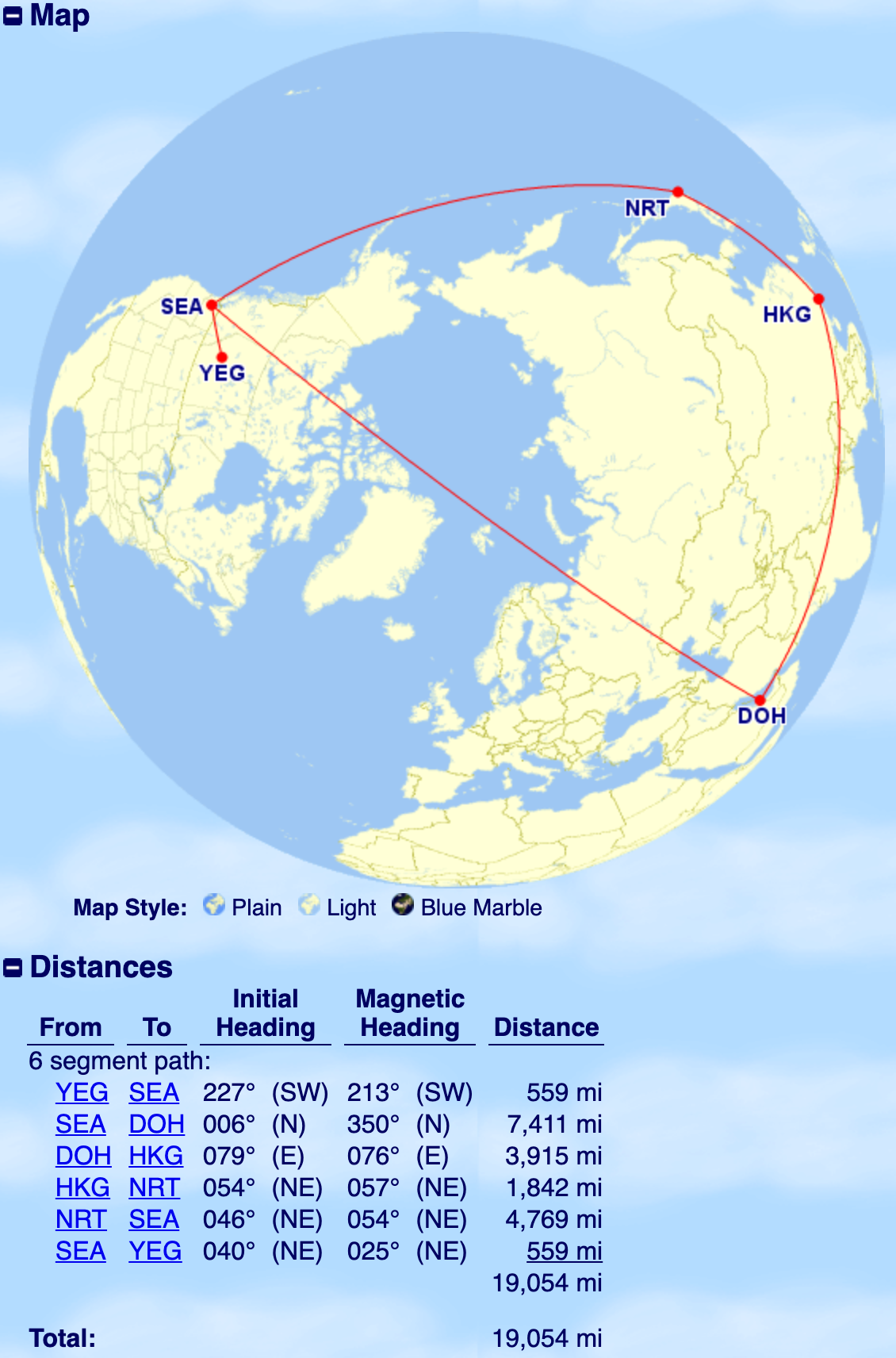
This would also be 200,000 Avios, or 165,000 Asia Miles, in business class.
(Unlike the Middle East circuit, you can also book this one with Asia Miles, because it satisfies the criteria of travelling on Cathay Pacific (from Hong Kong to Tokyo) once three or more partner airlines are introduced.)
Due to Seattle’s deficiencies as a proper Oneworld hub, you might have to make another connection before launching to another continent. That would mean two segments on both the outbound and the inbound legs of your journey. For example, you might fly something like Edmonton–Seattle–New York–around the world–Los Angeles–Seattle–Edmonton.
Keep that in mind if you plan on building a complex itinerary, as it would quickly chip away at the Avios limit of eight segments per multi-carrier ticket. If your routing is getting stretched beyond its limits, you might want to consider building an Asia Miles award instead, which allows fewer stopovers but more flight segments.
Either way, I’m getting fond flashbacks to the old Aeroplan three-stop mini-round-the-world awards… and if you can depart and return directly from home without a separate positioning ticket, even better!
What About North America Travel?
While Seattle may be lacking as a global gateway, Alaska Airlines does have a robust route network within the US. In addition to direct connections for overseas travel on partners, let’s see if it makes sense to redeem Oneworld points for our continental adventures.
(I should mention that Alaska’s routes were already bookable with Avios, Asia Miles, and American AAdvantage prior to their full entry into Oneworld, thanks to their pre-existing independent partnerships with these airlines. Still, it’s worth exploring whether these redemptions are worthwhile, considering that you can now more easily book Alaska flights with Avios online rather than over the phone.)
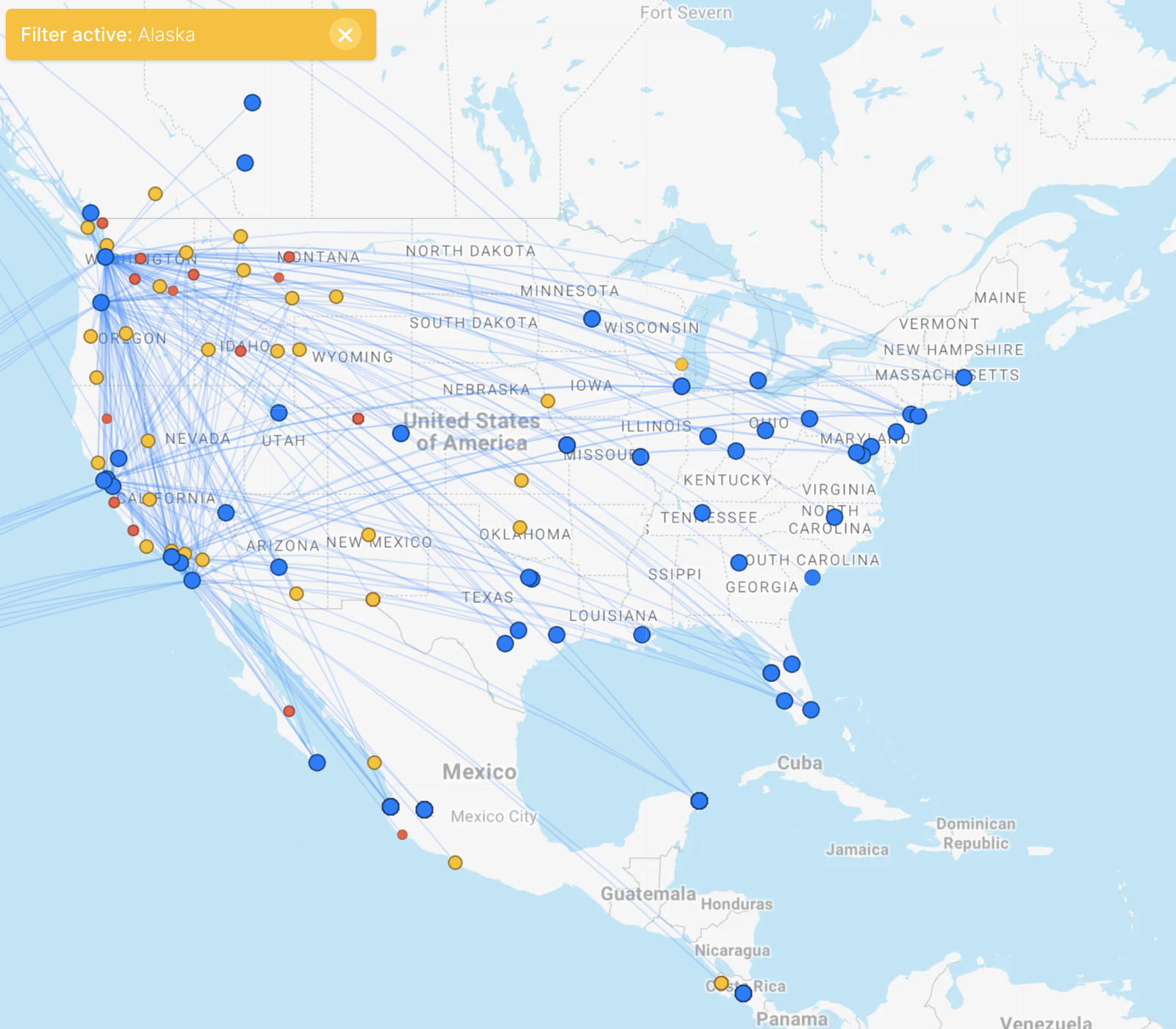
Award travel within North America can be a bit tricky for those of us tucked away in the Pacific Northwest. There’s not as much direct transcontinental traffic as on shorter north-south routes or the corridor between the densely metropolitan Northeast and Southern California.
Travel time is at a premium for shorter, weekend-warrior trips within North America. Personally, I try to minimize my time in transit by flying as directly as possible.
I prefer to make a short hop with a quick connection and settle in for a longer flight, rather than awkwardly break up the journey every few hours with transfers across the Midwest. But I also like to avoid taking a circuitous detour via Toronto or California. Those two goals are often at odds with each other.
With that in mind, I’m looking for new direct routes from Seattle, which is practically the same as a direct flight from BC, geographically speaking.
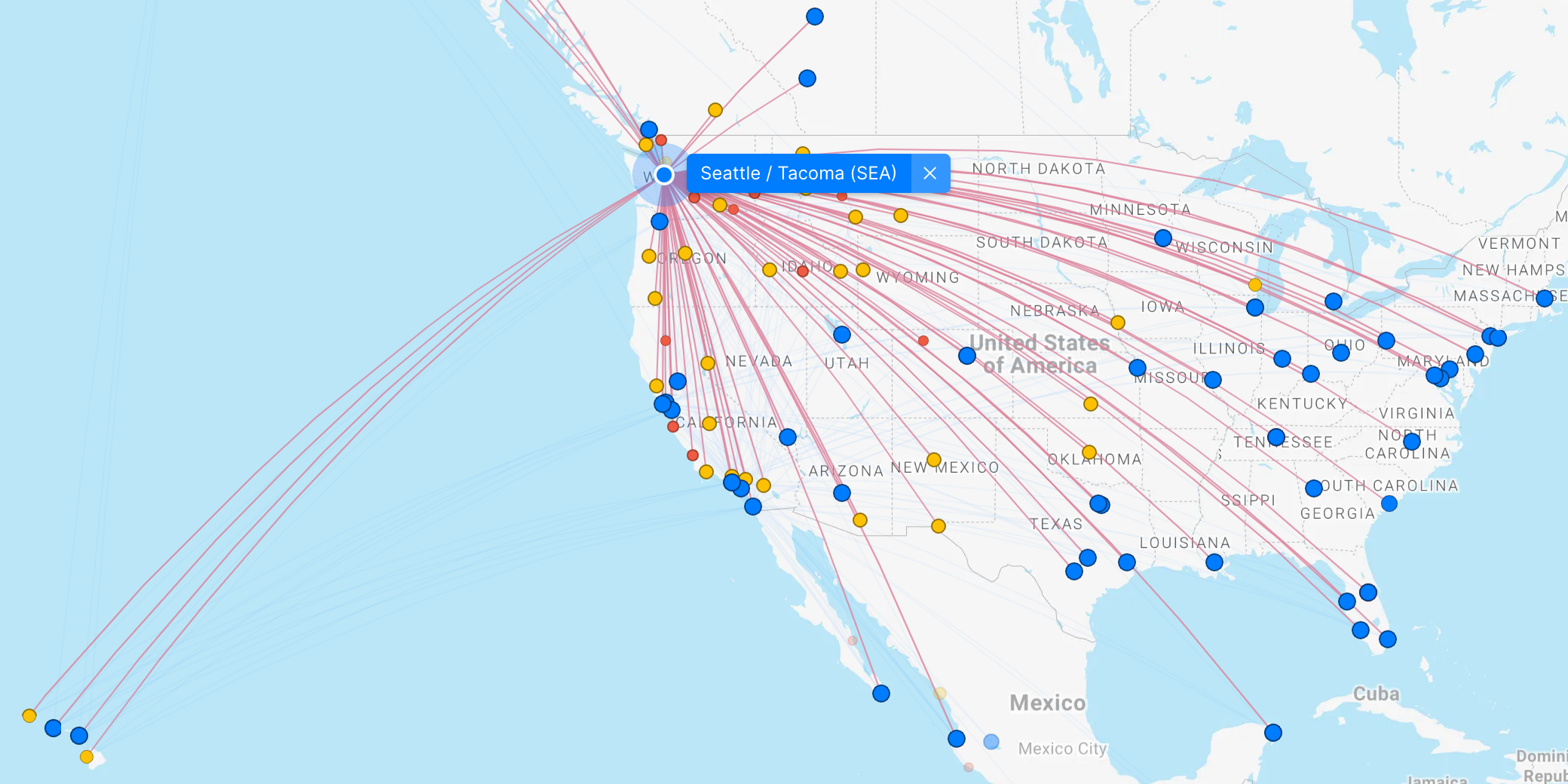
Pretty much anywhere in the US that you can fly to from Seattle, Alaska flies that route. Some new “nearly direct” destinations from Western Canada might include New Orleans, Charleston, San Antonio, Fort Myers, and Albuquerque.
The big winners here are Victoria and Kelowna, gaining a huge array of one-stop routing possibilities. The larger Canadian cities still enjoy direct connections to major US hubs like Denver, Chicago, Dallas, Houston, and Los Angeles, but it’s always good to have more options to avoid a routing that requires excessive transfers.
As for Sun destinations, I don’t think the Alaska and Oneworld development moves the needle much. We’ve already got good coverage from WestJet, even with direct flights from some smaller Canadian cities. But again, more options is always a plus, especially with disappointing changes to WestJet’s award program.
With that in mind, the question remains: is it even worth it to use Avios, Asia Miles, or AAdvantage miles for these routes?
For reference, here are Alaska’s “saver” rates (the same class that partner awards can book) for travel on their own aircraft:
- Under 700 miles: 5,000 or 15,000 Alaska miles in economy or business class
- Under 1,400 miles: 7,500 or 25,000 Alaska miles in economy or business class
- Under 2,100 miles: 10,000 or 25,000 Alaska miles in economy or business class
- Over 2,100 miles: 12,500 or 30,000 Alaska miles in economy or business class
These costs are lower across the board compared to using partner programs. In addition, other programs usually charge more for travel to Alaska (the state) than they do for flights within the contiguous 48 states, whereas Alaska (the airline) uses the same chart for both regions.
In general, I’ve noticed it’s generally better to stick with the same airline’s loyalty program for travel on their routes on their home turf, and that appears to be the case here with Alaska Airlines as well.
In doing so, you’ll have access to greater availability via higher fare classes (albeit at a higher points cost), and you can capitalize on things like seat sales and dynamic pricing that occasionally goes below the “bottom” of the scale.
Of course, it’s also important to factor in the earning side of the equation: Avios and Asia Miles tend to be easier to earn via credit card signup bonuses and transferrable points in Canada, so that might also sway your decision.
You might find it worthwhile to redeem slightly higher Avios or Asia Miles amounts for travelling on Alaska Airlines, while saving your Alaska miles for more valuable uses on international premium cabins instead.
Finding Availability & Booking Alaska Airlines Routes
Now that we’ve got a good handle on how to plan a Oneworld redemption on Alaska Airlines, we need to understand how to actually make a booking with each Oneworld loyalty program.
Let’s start with ExpertFlyer, so we know what to expect:

Economy seats are plentiful, so those should be a good indicator of whether or not the Alaska flight is bookable by a partner at all.
The British Airways Avios search tool is clearly picking up those seats, but only on one of the day’s three flights:

It looks like Avios books economy award tickets into the “T” fare class, and business award tickets into the “E” fare class. (Cross-referencing this with Alaska’s own search engine, they do show more seats, but with higher dynamic pricing once “saver” fares run out.)
Cathay Pacific Asia Miles is also showing Alaska availability, matching up with the same fare classes:
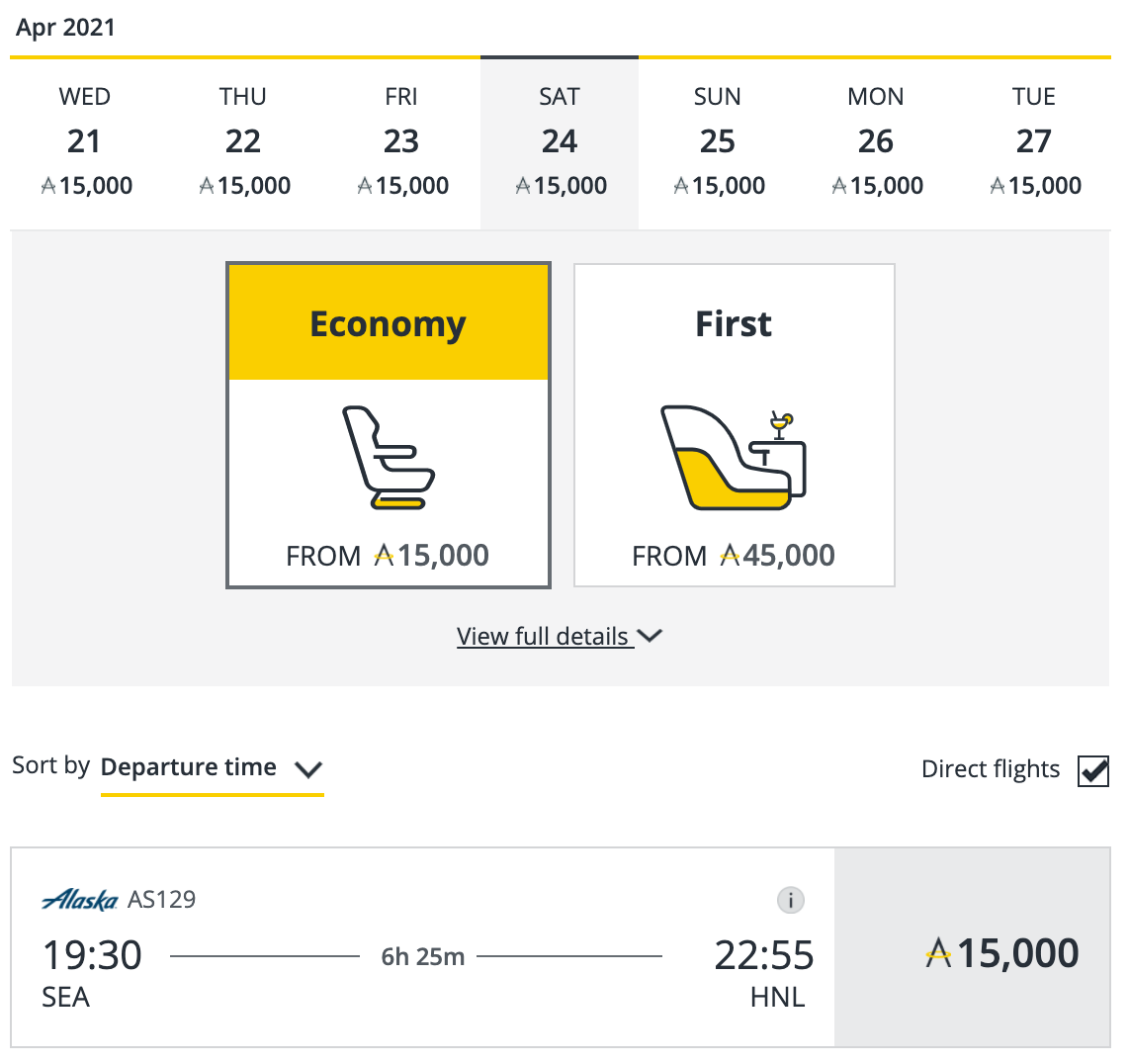
Rounding out our trifecta of Oneworld partners, American Airlines is working properly as well:

Avios and Asia Miles are unable to search for partner flights with connections, only direct flights, but I’m confident that they’d be able to book these segments on a longer itinerary through the call centre.
Meanwhile, AAdvantage does work online for connecting flights, so you could book something like Vancouver to Fort Lauderdale via Seattle without having to call.
In any event, you’ll probably want to call anyway: that’s the only way to book an Avios or Asia Miles multi-carrier award, and those charts are quite a bit more alluring than a simple intra-North America redemption.
Finally, you may have noticed that the three Oneworld programs are inconsistent in whether they offer “business” or “first” award space.
That’s because Alaska’s domestic “first class” isn’t a true First Class product; it’s more akin to business class or premium economy. Each search engine labels it a bit differently, but they all correspond to the same fare class, and the same physical seats in the cabin.
Conclusion
The implications of Alaska’s routes being added to the Oneworld network are all Seattle, Seattle, Seattle. It’s a welcome development for residents of Victoria and Kelowna, whose options for direct connections are otherwise limited, and to a lesser extent Edmonton, Calgary, and Vancouver.
The biggest benefit is greater access to Oneworld multi-carrier awards from those five cities, as well as a wider range of routing options for all multi-carrier awards as a whole.
Meanwhile, North American redemptions on Alaska flights are still best booked within the Mileage Plan program. However, if you have a relatively large balance of transferable points from RBC Avion or American Express Membership Rewards and a smaller balance of Alaska miles, then you’ll now find it easier to redeem Avios, Asia Miles, and AAdvantage miles on Alaska flights using the online search engine.
For now, these impacts are relatively limited in scope, and the bigger news is still yet to come. We continue to await further updates from Alaska Mileage Plan themselves, which will inform us of any changes to the award charts for Oneworld partner awards (both old and new) using our Alaska miles.


















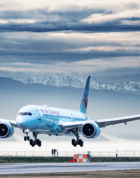

Josh, can you clarify the round trip business class Edmonton to Doha via Seattle for 200000 Avios. I see on the multi carrier chart the business class value is 120000 points for the 4,001 to 9,000 distance band. I must have missed something.
Thanks…..
Unlike regular Avios awards, the multi-carrier chart considers the distance of the entire ticket before determining the points cost. Round-trip is 15,940 miles, slotting in at 14,001-20,000.